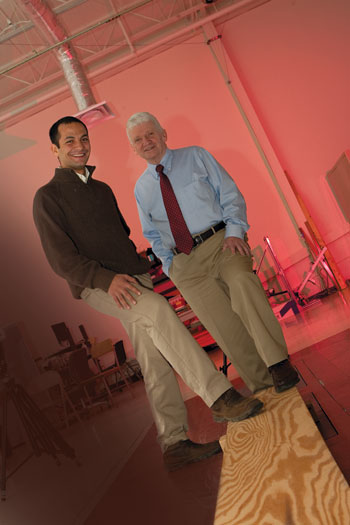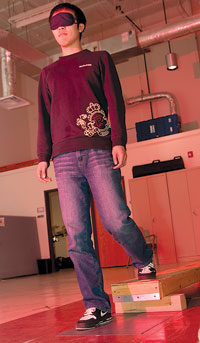Study analyzes fractures step by (mis)step

RESEARCH | The scenario seems as obvious as it is devastating: An elderly person stumbles on a step or trips on a curb and falls, and the impact of landing fractures a fragile hipbone.
Researchers at the University, however, set out to see if the actual sequence of events in some of these injuries might be different.
“For our study, we posed a chicken-and-egg question,” says Mehmet Uygur, a doctoral student in UD’s interdisciplinary Biomechanics and Movement Science Program, who earned his master’s degree in biomechanics in 2008. “Which came first—the fall or the fracture?”
The findings of the research team turned out to be groundbreaking, demonstrating for the first time that the force exerted on a bone by an elderly person’s misstep is enough by itself to cause a fracture, Uygur says. That injury would, of course, almost immediately result in a fall.

“The results were very significant,” says David Barlow, associate professor of health, nutrition and exercise sciences, who was Uygur’s adviser for his master’s thesis and a member of the research team. “We found that the forces that occur in a misstep are astoundingly high, as much as eight times the person’s body weight. That’s so high that it seems likely that a misstep that causes a fracture is something that happens quite often.”
More research will be needed to learn how frequently that scenario occurs, Barlow says, “but now we’ve demonstrated that it can happen, so there’s a lot of interest in these findings.”
The research was published in 2009 in the Journal of Biomechanics, with Uygur as the lead author, marking the first time a UD graduate student was published in that prestigious journal, according to Jim Richards, Distinguished Professor of Health, Nutrition and Exercise Sciences. Uygur also won a “best presentation” award at the annual biomechanics symposium held last spring at the University’s Center for Biomedical Engineering Research.
Other members of the research team and co-authors of the journal article, in addition to Uygur, Richards and Barlow, were Slobodan Jaric, professor of health, nutrition and exercise sciences, and then-graduate student Paulo B. de Freitas, who has since completed his doctorate.
To conduct the research, Uygur constructed a 7-inch-high box—the height of a standard stair step—and placed it on top of a force plate in the floor of the University’s high-tech Human Performance Lab. The height of the box was level with an adjacent platform on which the research participants could walk for a few strides. All the participants were young, healthy adults who were uninjured during any of the experiments, Uygur notes.
Each participant took part in four different activities: walking along the platform and stepping onto the box; walking along the platform and stepping down, where the box had been removed; and doing each of those activities while blindfolded. In the situation where a blindfolded participant stepped down, he or she was not aware that the box had been taken away. Uygur says that situation provided the key to measuring the force that occurs when someone missteps.
“When you know that you’re going to be stepping down, your ankle flexes so that you land on your toes, and your knee flexes slightly also,” Uygur says. “That dissipates a lot of force. But if you don’t realize that you’re stepping down, your heel hits first [as if you were walking on a level surface] and your leg is stiff, and that misstep applies a lot of force to your bones, especially the joint in your hip.”
While the force plate in the floor measured the impact of the research participants’ steps, they also were tracked by Human Performance Lab cameras that translated their motions into a three-dimensional image on a nearby computer screen. With the variety of data gathered, the researchers were able to calculate the force that normal stepping and misstepping exerted on the participants’ bones.
Previous research has determined how much force is needed to cause bone fractures in an elderly person, and Uygur says the team’s calculations found that more than enough force occurred in missteps.
“Misstepping is a common occurrence at any age but especially in the elderly,” Barlow says. “If this research can be used to prevent fractures, that’s extremely important. Twenty percent of the elderly people who sustain hip fractures pass away within the next year.”
Uygur says he also hopes the research can eventually be used for prevention, perhaps by modifying elderly residents’ homes to eliminate changes in elevation, by making steps lower than their current standard height or by designing a shoe that could reduce the impact from a misstep.
“I don’t know where this will go, but I think we’ve opened up a lot of possibilities,” he says.
Article by Ann Manser, AS ’73





